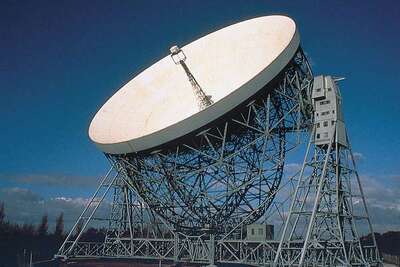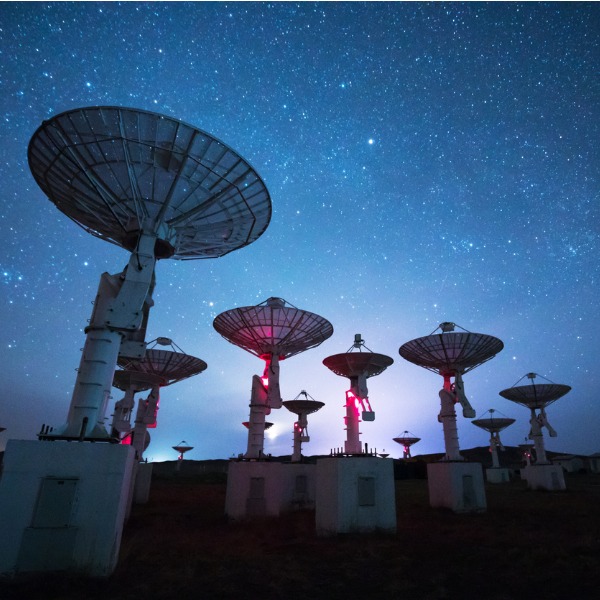Which Astronomical Objects Are Best Studies With Radio Telescopes
Radio astronomy is a subfield of astronomy that studies celestial objects at radio frequencies. An astronomical interferometer or telescope array is a set of separate telescopes mirror segments or radio telescope antennas that work together as a single telescope to provide higher resolution images of astronomical objects such as stars nebulas and galaxies by means of interferometry.

The Radiotelescopes Use Large Parabolic Antennas To Capture Radio Waves
Astronomical research is almost solely dependent on information we gather from the light of celestial bodies their brightness color and movement.
. It also includes the study of astronomical objects not visible to the naked eye or beyond Earths atmosphere. The advantage of this technique is that it can theoretically produce images with. The first detection of radio waves from an astronomical object was in 1933 when Karl Jansky at Bell Telephone Laboratories reported radiation coming from the Milky Way.
Optical telescopes are based on the refractive properties of lenses. Red regions are the most intense blue the least. Colors have been added to help the eye sort out regions of different radio intensities.
The VLA consists of 27 antennas arranged in a huge Y pattern up to 36 km across roughly one-and-one-half times the size of Washington DC. Start studying Radio Telescopes. The advantage of this technique is that it can theoretically produce images with.
Due to their precision these emission properties can be used as clocks and for measurements to find out astronomical distances or other relevant quantities. This image has been constructed of radio observations at the Very Large Array of a galaxy called Cygnus A. Galileo Galilei created the first optical telescope.
Research top-rated resources about Radio Astronomy at Best of the Web Directory. The emissions are picked up here on Earth by radio telescopes. For millennia humans could only observe the cosmos in visible light but visible light constitutes only a tiny portion of the.
Radio astronomy is the study of objects and processes in space that emit radio frequencies. Astronomy draws upon mathematics physics chemistry and geology. Radio telescopes are the biggest telescopes because they have to.
Every source detected to date is a naturally occurring one. The telescopes are a known distance apart on the ground. These are some of the most distant objects in the Universe and are believed to be fueled by supermassive black holes residing in ancient galaxies.
2 more light gathers enabling astronomers to see more smaller and dimmer celestial objects. Radio-emitting quasars were the first to be discovered. The National Radio Astronomy Observatorys Very Large Array VLA radio telescope in New Mexico is one of the worlds premier astronomical radio observatories.
Radio telescope astronomical instrument consisting of a radio receiver and an antenna system that is used to detect radio-frequency radiation between wavelengths of about 10 metres 30 megahertz MHz and 1 mm 300 gigahertz GHz emitted by extraterrestrial sources such as stars galaxies and quasars. An astronomical interferometer or telescope array is a set of separate telescopes mirror segments or radio telescope antennas that work together as a single telescope to provide higher resolution images of astronomical objects such as stars nebulas and galaxies by means of interferometry. Radio telescopes are the main observing instrument used in radio astronomy which studies the radio frequency portion of the electromagnetic spectrum emitted by astronomical objects just as optical telescopes are the main observing instrument used in.
1 allows all colors of light from an object to be seen in focus at the same time. Subsequent observations have identified a number of different sources of radio emission. An astronomical telescope is a device that allows us to gather data on very distant objects in the universe.
Your guide to scientific knowledge including the disciplines of animal husbandrybiologicalobservations experimental investigations of ourselves the planet and the universe. Radio Astronomy is the study of radio waves produced by a multitude of astronomical objects such as Sun planets pulsars stars star-forming regions ie birthplace of stars gas clouds galaxies supernova remnants etc. We see the slight difference in the way the waves show up with one arriving slightly behind the other.
We can use radio telescopes to examine radio waves from astronomical objects like stars black holes etc. These are large instruments as it is necessary for the detector area to be larger than the detectable wavelengths. The radio waves coming from the source will therefore arrive at one telescope at a slightly different time than the other.
2mirrors can be big. Radio Astronomy. The difference is a time delay in the phase of the wave.
Since supernovae are chaotic events and the whole momentum needs to be conserved the small remnant object left behind by them spins very fast which makes it a source of emission of radio waves. Specialized antenna and radio receiver used to detect radio waves from astronomical radio sources in the sky. Radio telescope is an astronomical instrument consisting of a radio receiver and an antenna system that is used to detect radio-frequency radiation emitted by extraterrestrial sources.
305-meter dish at the Arecibo Observatory the worlds largest radio telescope. Astronomical Telescopes - Key takeaways. List three advantages of reflecting telescopes over refractors.
See radio and radar astronomy Extraterrestrial radio emission. 1 objects are more clearer and more focused. The visible galaxy would be a small dot in the center of the image.
Or a planet for example astronomers study it in as many wavelengths as possible including the radio range. Astronomy is the science and study of celestial objects such as stars galaxies planets moons comets and nebulae. The high sensitivity of the Arecibo radio telescope allows astronomers to detect faint radio signals from far-off regions.
Learn vocabulary terms and more with flashcards games and other study tools. Because radio wavelengths are much longer than those of visible light radio telescopes must be very large in order to attain the resolution of optical telescopes.
How Does A Radio Telescope Work Quora
What Is The Difference Between A Radio And A Satellite Telescope Quora

0 Response to "Which Astronomical Objects Are Best Studies With Radio Telescopes"
Post a Comment